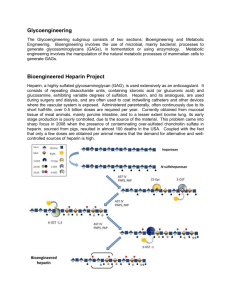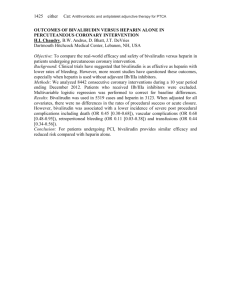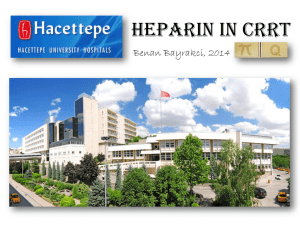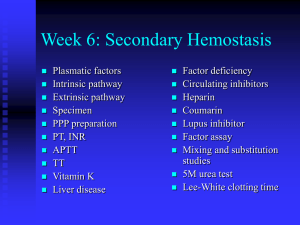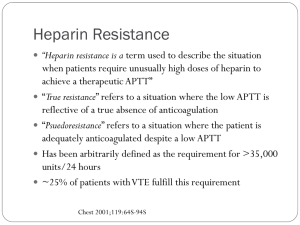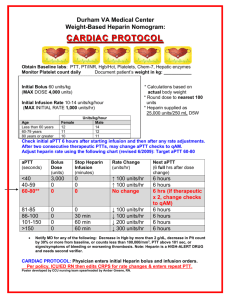Meta-regression Analysis of Published Preclinical Studies
advertisement
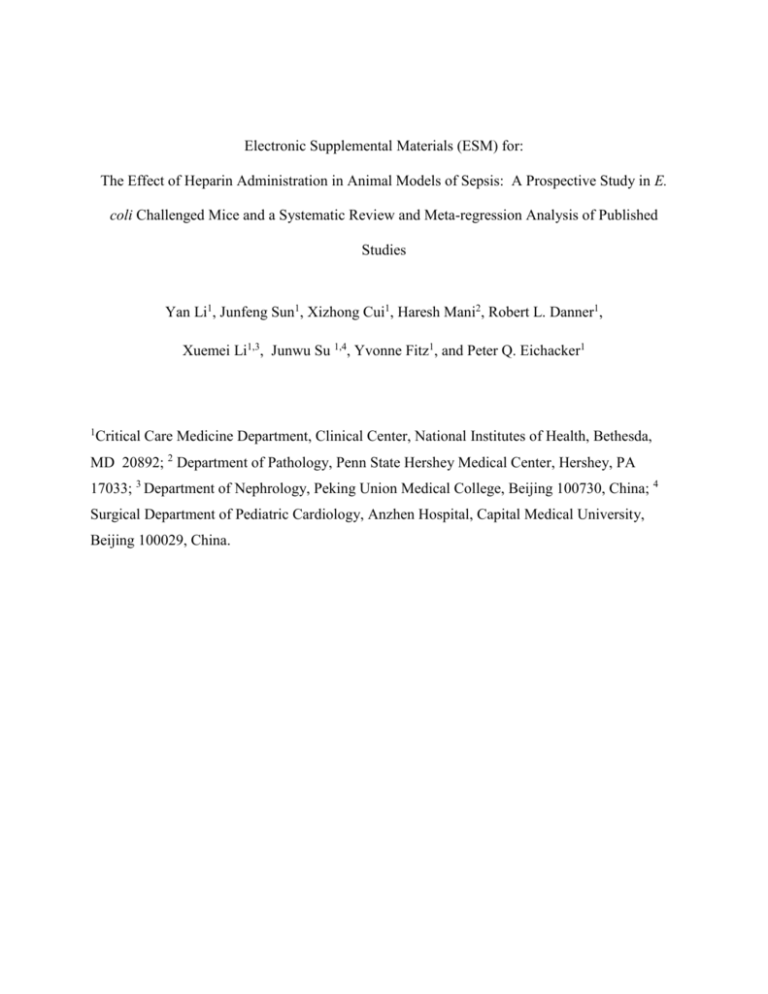
Electronic Supplemental Materials (ESM) for: The Effect of Heparin Administration in Animal Models of Sepsis: A Prospective Study in E. coli Challenged Mice and a Systematic Review and Meta-regression Analysis of Published Studies Yan Li1, Junfeng Sun1, Xizhong Cui1, Haresh Mani2, Robert L. Danner1, Xuemei Li1,3, Junwu Su 1,4, Yvonne Fitz1, and Peter Q. Eichacker1 1 Critical Care Medicine Department, Clinical Center, National Institutes of Health, Bethesda, MD 20892; 2 Department of Pathology, Penn State Hershey Medical Center, Hershey, PA 17033; 3 Department of Nephrology, Peking Union Medical College, Beijing 100730, China; 4 Surgical Department of Pediatric Cardiology, Anzhen Hospital, Capital Medical University, Beijing 100029, China. Methods Animal Care All studies were approved by the Animal Care and Use Committee of the Clinical Center of the National Institutes of Health. Prospective Studies Design Study 1. Effect of Heparin on aPTT, PT and Fibrinogen in Non-challenged Animals Mice (C57BL/6J) were randomized to receive IP heparin (Sterile and non-pyrogenic, Abraxis Pharmaceutical Products, Schaumburg, IL) 100 (n= 29), 500 (n=30), or 2500 (n=11) units/kg or diluent (placebo, n= 32). From 0.5 to 4 h after treatment, randomly selected animals were anesthetized with isoflurane and had blood drawn for aPTT, prothrombin time (PT) and fibrinogen measures (Figure 1, Panel A). An untreated group also had tests performed (baseline animals) (n= 5). Study 2. Effect of E. coli Challenge and Heparin on Survival and Other Measures To study survival, animals were briefly anesthetized and challenged with intra-tracheal E. coli (15 x 109 CFU/kg). Animals were then randomly selected to receive heparin 100 (n= 42), 500 (n= 42) or 2500 (n= 18) units/kg or placebo (n= 40) (IP, q12 h for 48 h and then q24 h for 48 h) beginning immediately after challenge (Figure 1, Panel B). The pattern of mortality anticipated in the model and the personnel resources available for dosing were the basis for the treatment regimen employed. All animals received antibiotics [ceftriaxone, Roche Laboratories Inc., Nutley, NJ, 100 mg/kg in 0.1 ml, subcutaneously (SC), q24 h for 96 h] and fluids (normal saline, 0.5 ml, SC on the day of challenge) beginning 4 h after challenge. Animals were observed every 2 h for the first 24 h, every 4 h for the second 24 h, and then every 12 h for up to 168 h. One experiment was conducted each week and included up to 24 animals in each distributed equally between control and treatment groups. The term “experiment” refers to weekly experiments. For other laboratory measures, a second set of animals were challenged with E. coli and randomized to treatment with heparin 100 (n= 59) or 500 (n= 63) units/kg or placebo (n= 46) and supported as above. Randomly selected animals at 24 h and all those remaining at 48 h had blood collected for aPTT, PT, fibrinogen, thrombin-anti-thrombin complex (TATc), complete blood count (CBC), and 12 cytokine levels. Then the lungs of randomly selected animals were lavaged for cell, protein, TATc and quantitative bacteria measures while those of remaining animals were divided for histology and wet to dry weight ratio calculations. As non-infected controls, additional animals were challenged with IT normal saline (NS), treated with placebo and sampled at 24 or 48 h (n=8 per time point). Weekly experiments were performed as with survival and animals were distributed among infected groups with and without heparin treatment and the noninfected group. Coagulation Measures At the selected time points (before and 0.5, 1, 2 and 4 h after heparin administration in study 1, 24 and 48 h after E. coli inoculation in study 2), randomly selected animals were anesthetized completely with isoflurane. Abdomen was then opened and blood was drawn from the inferior vena cava. The blood was mixed with 3.2% sodium citrate in the ratio of 9:1. After centrifugation at 5000 rpm 5 mins, plasma was used to measure aPTT, PT and fibrinogen with a biphasic transmittance method using Trilogy Clinical Chemistry, ELISA and Coagulation system (Drew Scientific, Dallas, TX), which is designed for animal study. The aPTT, PT and fibrinogen measures were done with mouse specific assays. Detection limits for these tests are 15 – 180s, 8 – 150s and 100 – 600 mg/dl respectively. CVs are 8%, 9% and 4% respectively. The plasma thrombin-antithrombin complex (TATc) levels were determined using Enzygnost TAT micro ELISA kits (Dade Behring Inc., Newark, DE). The TATc assay was human specific but had been shown previously to be sensitive in a mouse model of sepsis (Giebelen IAJ, et al. Am J Respir Cell Mol Biol. 2008; 39: 373-379). Other Blood and Lung Lavage and Tissue Measures In another set of animals, after blood was withdrawn from the inferior vena cava, part of the sample employed for complete blood cell (CBC) counts (ZB1, Coulter Electronic, Hialeah, FL). Remaining blood was centrifuged and plasma was stored for cytokine analysis. The cytokines analysis [interleukin (IL)-, IL-1, IL-2, IL-4, IL-6, IL-10, tumor necrosis factor (TNF) , interferon (IFN) , granulocyte macrophage colony-stimulating factor (GM-CSF), migratory inhibitory proteins (MIP-1), monocyte chemoattractant protein (MCP-1) and RANTES (regulated on activation, normal T-cell expressed and secreted)] was made using a protein multiplex immunoassay system (Mouse Lincoplex Kit, Millipore, St. Charles, MO). This was a mouse specific assay. In one set of animals, after cervical dislocation, lavage was performed by cannulating the trachea with a plastic artery catheter and sequentially lavaging with three 0.7ml aliquots of PBS were combined. Part of the lavage fluid was taken for quantitative bacteria measures. Remaining fluid was centrifuged, the supernatant was removed, and the cell pellet was resuspended. Cell counts were performed with an electronic cell counter (Z1 Coulter Particle Counter, Coulter Electronics, Miami, FL). Slides for differential cell counts were prepared (Cytospin 4, Thermo Shandon, Pittsburgh, PA) and stained. Cell differentials were performed on each slide. Lavage supernatants were passed through a 45µm filter. TATc levels were determined as with plasma, and protein determinations were made using a Folin-Lowry technique. In another set of animals, two lung lobes were removed. To perform histological analysis, one lung lobe was cannulated and infused and fixed with 10% formalin and stained with hemotoxylin and eosin for reading by a pathologist blinded to study groups. The degree of injury was numerically graded (0, absent, to 4, severe) for six different parameters including interstitial capillary congestion, interstitial edema, alveolar edema, alveolar hemorrhage, alveolar fibrin and pneumocyte hyperplasia. For wet/dry determination, another lung lobe was removed and immediately weighed, air-dried for 1 wk, then reweighed. Alveolar neutrophil infiltration was quantified and averaged from 10 high power fields (400 X). Statistics A two-group t-test with unequal variance (Satterthwaite’s method) was used to analyze the effects of heparin on aPTT and PT levels (8). Survival (hazard ratio of death) was analyzed with a Cox proportional hazard (PH) model accounting for heparin treatment and dose category in each weekly experiment. The proportional hazard regression was stratified by experiment (9). The actual dose was used in a separate Cox PH model to assess the dose-response relationship. All other data was analyzed with a linear mixed model (10). A random experiment effect was included to account for correlation within each experiment. A standard residual diagnosis check model investigated distribution assumptions and outlying values (10). Only one outlying value was noted (a PT value in a normal saline challenged animal). Including this value gave similar results although less significant (p=0.03). Data were transformed (log10) as indicated to meet the model assumptions of normality and constant variance. For those log10-transformed variables, their (geometric) means can be easily calculated from the means of their log10-transformed counterparts by taking an anti-log. A lung histology score comprised of the 6 injury measures was calculated. Each measure has a value ranging from 0 to 4 (with 4 being the worst). A total score (Pathology Score) was calculated by summing the 6 measures together. For survival and aPTT levels (considered primary endpoints), a p-value ≤ 0.05 was considered significant. For all other parameters (secondary endpoints), a p-value ≤ 0.01 was considered significant to control for potential false positive findings. Simple summary statistics (mean SEs, medians and ranges) were plotted in Figures 2 and 4, and tabulated in Tables 1 and 2 to show the “raw” data. Statistical analyses were conducted using SAS version 9.1. The number of animals employed in survival studies was based on an estimated mortality of 80% with placebo, a 50% reduction in mortality with a given dose of heparin (i.e. a reduction from 80% to 40% mortality), and an at least 80% power to show that the difference between placebo and treatment was significant at a two-sided 0.05 level. Study with the highest heparin dose was terminated early due to the high observed mortality. Additional animals were ultimately studied with the two lower heparin doses to ensure potential beneficial trends were not overlooked. The number of animals employed for other assays was based on prior laboratory experience with the model. Meta-regression Analysis of Published Preclinical Studies An English language literature search of animals studies using Medline and Embase was conducted from 1960 to the present using the terms; sepsis, septic shock, heparin, anti-coagulant, anti-thrombotic, and treatment. Available studies were reviewed for additional references. Studies included had to have reported and compared the effects of heparin treatment to placebo on mortality in a preclinical animal model of sepsis employing either a bacterial or bacterial toxin challenge. One investigator (YL) reviewed included studies by using a standardized data collection form. Concerns regarding the inclusion or exclusion of a study were addressed by two investigators (YL and PQE). Other abstracted data included : the species investigated, the route (IV, IP or other) and type [mono-bacteria, LPS, or surgically induced infection with intestinal perforation or ischemia (termed surgical poly-microbial infection)] of septic challenge, the route, dose and timing of heparin treatment, the presence or absence of concurrent antibiotic or fluid support, and the duration of observation. Studies of heparin in models utilizing other antiinflammatory therapies were excluded (e.g. anti-cytokine or anti-LPS agents). Preclinical animal studies typically do not report methods regarding randomization and blinding procedures and these parameters were not included in analysis. Two or more experiments appearing in the same paper were treated as separate studies. For all included experiments, the effect of heparin treatment on the odds ratio (OR) of death was analyzed. Experiments with no death or no survivor in both arms were excluded since the OR is undefined. To allow calculation of log (OR) for experiments in which all animals either died or all survived in one treatment arm, the value of 0.5 was added to the number of deaths and non-deaths for each treatment arm. A random effects meta-regression analysis was used to investigate the influence of recorded variables on the effects of heparin across studies (12). Heterogeneity among studies was assessed using the Q statistic and I2 value (11). Due to significantly different treatment effects across challenge type (see Results), we conducted metaanalyses for each of the three types of septic challenge separately. A random-effects metaanalysis was used to estimate the overall impact of heparin treatment for each challenge type (13). The heterogeneity among species within each challenge was assessed using random-effect meta-regression. Based on findings from the prospective experiments in the mouse pneumonia model, the association between treatment effect and heparin dose within each challenge type was also assessed for published studies using weighted Spearman correlation. Dose was only noted to potentially influence the effects of heparin in published studies with mono-bacterial challenge and this is reported below. Sensitivity analysis was performed to determine whether any individual study contributed disproportionately to the result by assessing the influence of sequential removal of individual studies on the heparin effect. Potential publication bias and its influence on the effects of heparin across studies was evaluated with an Eggers regression (14) and a Duval and Tweedie’s trim and fill analysis, respectively (15). Summary ORs are reported when heterogeneity was low (≤30% I2 value) or represented quantitative differences in an otherwise similarly directed effects among studies (i.e. quantitative as opposed to qualitative heterogeneity). Meta-analyses were done using Comprehensive Meta-analysis version 2 (http://www.meta-analysis.com/) except multivariate random-effect meta-regression which was done using SAS Proc Mixed (12).



